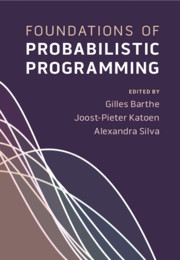Refine search
Actions for selected content:
48532 results in Computer Science
14 - The Basic Idea behind Expectation-Maximization
- from Part V - Advanced Topics
-
- Book:
- Essentials of Pattern Recognition
- Published online:
- 08 December 2020
- Print publication:
- 19 November 2020, pp 316-332
-
- Chapter
- Export citation
3 - Overview of a Pattern Recognition System
- from Part I - Introduction and Overview
-
- Book:
- Essentials of Pattern Recognition
- Published online:
- 08 December 2020
- Print publication:
- 19 November 2020, pp 44-62
-
- Chapter
- Export citation
List of Figures
-
- Book:
- Essentials of Pattern Recognition
- Published online:
- 08 December 2020
- Print publication:
- 19 November 2020, pp ix-x
-
- Chapter
- Export citation
9 - Distance Metrics and Data Transformations
- from Part III - Classifiers and Tools
-
- Book:
- Essentials of Pattern Recognition
- Published online:
- 08 December 2020
- Print publication:
- 19 November 2020, pp 196-218
-
- Chapter
- Export citation
Part V - Advanced Topics
-
- Book:
- Essentials of Pattern Recognition
- Published online:
- 08 December 2020
- Print publication:
- 19 November 2020, pp 291-292
-
- Chapter
- Export citation
7 - Classifiers and Tools
- from Part III - Classifiers and Tools
-
- Book:
- Essentials of Pattern Recognition
- Published online:
- 08 December 2020
- Print publication:
- 19 November 2020, pp 143-172
-
- Chapter
- Export citation
2 - Learning Algorithms
- from Part I - Fundamental Theories
-
- Book:
- Machine Learning for Speaker Recognition
- Published online:
- 26 June 2020
- Print publication:
- 19 November 2020, pp 13-35
-
- Chapter
- Export citation
Part III - Classifiers and Tools
-
- Book:
- Essentials of Pattern Recognition
- Published online:
- 08 December 2020
- Print publication:
- 19 November 2020, pp 141-142
-
- Chapter
- Export citation
Preface
-
- Book:
- Essentials of Pattern Recognition
- Published online:
- 08 December 2020
- Print publication:
- 19 November 2020, pp xiii-xv
-
- Chapter
- Export citation
Frontmatter
-
- Book:
- Machine Learning for Speaker Recognition
- Published online:
- 26 June 2020
- Print publication:
- 19 November 2020, pp i-iv
-
- Chapter
- Export citation
10 - Information Theory and Decision Trees
- from Part III - Classifiers and Tools
-
- Book:
- Essentials of Pattern Recognition
- Published online:
- 08 December 2020
- Print publication:
- 19 November 2020, pp 219-242
-
- Chapter
- Export citation

Foundations of Probabilistic Programming
-
- Published online:
- 18 November 2020
- Print publication:
- 03 December 2020
-
- Book
-
- You have access
- Open access
- Export citation
Automatic classification of participant roles in cyberbullying: Can we detect victims, bullies, and bystanders in social media text?
-
- Journal:
- Natural Language Engineering / Volume 28 / Issue 2 / March 2022
- Published online by Cambridge University Press:
- 18 November 2020, pp. 141-166
-
- Article
- Export citation
Comparison of rule-based and neural network models for negation detection in radiology reports
-
- Journal:
- Natural Language Engineering / Volume 27 / Issue 2 / March 2021
- Published online by Cambridge University Press:
- 18 November 2020, pp. 203-224
-
- Article
- Export citation
A tEEG framework for studying designer’s cognitive and affective states
- Part of
-
- Journal:
- Design Science / Volume 6 / 2020
- Published online by Cambridge University Press:
- 17 November 2020, e29
-
- Article
-
- You have access
- Open access
- HTML
- Export citation
Numerical simulation, clustering, and prediction of multicomponent polymer precipitation
-
- Journal:
- Data-Centric Engineering / Volume 1 / 2020
- Published online by Cambridge University Press:
- 17 November 2020, e13
-
- Article
-
- You have access
- Open access
- HTML
- Export citation
Hodge Representations
- Part of
-
- Journal:
- Experimental Results / Volume 1 / 2020
- Published online by Cambridge University Press:
- 17 November 2020, e51
-
- Article
-
- You have access
- Open access
- HTML
- Export citation
Design margins in industrial practice
- Part of
-
- Journal:
- Design Science / Volume 6 / 2020
- Published online by Cambridge University Press:
- 17 November 2020, e30
-
- Article
-
- You have access
- Open access
- HTML
- Export citation
Uninterruptible Power Supply Improves Precision and External Validity of Telomere Length Measurement via qPCR
-
- Journal:
- Experimental Results / Volume 1 / 2020
- Published online by Cambridge University Press:
- 16 November 2020, e52
-
- Article
-
- You have access
- Open access
- HTML
- Export citation
ROB volume 38 issue 12 Cover and Front matter
-
- Article
-
- You have access
- Export citation





